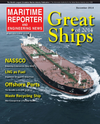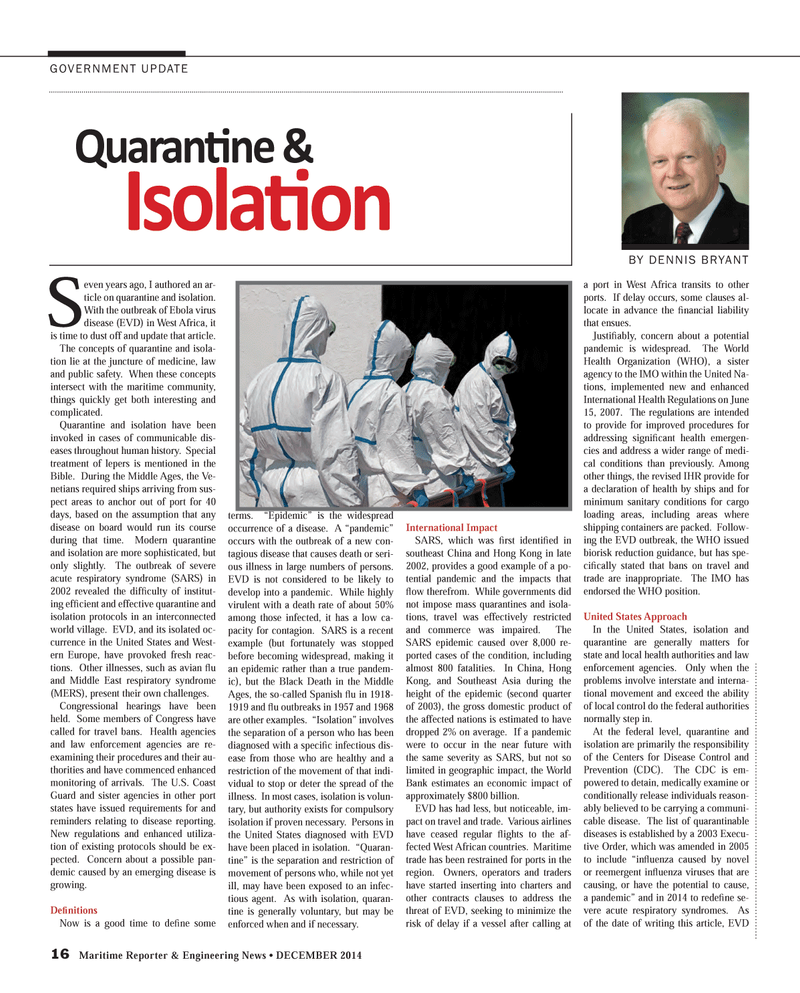
Page 16: of Maritime Reporter Magazine (December 2014)
Great Ships of 2014
Read this page in Pdf, Flash or Html5 edition of December 2014 Maritime Reporter Magazine
16 Maritime Reporter & Engineering News • DECEMBER 2014
GOVERNMENT UPDATE
S even years ago, I authored an ar- ticle on quarantine and isolation.
With the outbreak of Ebola virus disease (EVD) in West Africa, it is time to dust off and update that article.
The concepts of quarantine and isola- tion lie at the juncture of medicine, law and public safety. When these concepts intersect with the maritime community, things quickly get both interesting and complicated.
Quarantine and isolation have been invoked in cases of communicable dis- eases throughout human history. Special treatment of lepers is mentioned in the
Bible. During the Middle Ages, the Ve- netians required ships arriving from sus- pect areas to anchor out of port for 40 days, based on the assumption that any disease on board would run its course during that time. Modern quarantine and isolation are more sophisticated, but only slightly. The outbreak of severe acute respiratory syndrome (SARS) in 2002 revealed the diffi culty of institut- ing effi cient and effective quarantine and isolation protocols in an interconnected world village. EVD, and its isolated oc- currence in the United States and West- ern Europe, have provoked fresh reac- tions. Other illnesses, such as avian fl u and Middle East respiratory syndrome (MERS), present their own challenges.
Congressional hearings have been held. Some members of Congress have called for travel bans. Health agencies and law enforcement agencies are re- examining their procedures and their au- thorities and have commenced enhanced monitoring of arrivals. The U.S. Coast
Guard and sister agencies in other port states have issued requirements for and reminders relating to disease reporting.
New regulations and enhanced utiliza- tion of existing protocols should be ex- pected. Concern about a possible pan- demic caused by an emerging disease is growing.
Defi nitions
Now is a good time to defi ne some terms. “Epidemic” is the widespread occurrence of a disease. A “pandemic” occurs with the outbreak of a new con- tagious disease that causes death or seri- ous illness in large numbers of persons.
EVD is not considered to be likely to develop into a pandemic. While highly virulent with a death rate of about 50% among those infected, it has a low ca- pacity for contagion. SARS is a recent example (but fortunately was stopped before becoming widespread, making it an epidemic rather than a true pandem- ic), but the Black Death in the Middle
Ages, the so-called Spanish fl u in 1918- 1919 and fl u outbreaks in 1957 and 1968 are other examples. “Isolation” involves the separation of a person who has been diagnosed with a specifi c infectious dis- ease from those who are healthy and a restriction of the movement of that indi- vidual to stop or deter the spread of the illness. In most cases, isolation is volun- tary, but authority exists for compulsory isolation if proven necessary. Persons in the United States diagnosed with EVD have been placed in isolation. “Quaran- tine” is the separation and restriction of movement of persons who, while not yet ill, may have been exposed to an infec- tious agent. As with isolation, quaran- tine is generally voluntary, but may be enforced when and if necessary.
International Impact
SARS, which was fi rst identifi ed in southeast China and Hong Kong in late 2002, provides a good example of a po- tential pandemic and the impacts that fl ow therefrom. While governments did not impose mass quarantines and isola- tions, travel was effectively restricted and commerce was impaired. The
SARS epidemic caused over 8,000 re- ported cases of the condition, including almost 800 fatalities. In China, Hong
Kong, and Southeast Asia during the height of the epidemic (second quarter of 2003), the gross domestic product of the affected nations is estimated to have dropped 2% on average. If a pandemic were to occur in the near future with the same severity as SARS, but not so limited in geographic impact, the World
Bank estimates an economic impact of approximately $800 billion.
EVD has had less, but noticeable, im- pact on travel and trade. Various airlines have ceased regular fl ights to the af- fected West African countries. Maritime trade has been restrained for ports in the region. Owners, operators and traders have started inserting into charters and other contracts clauses to address the threat of EVD, seeking to minimize the risk of delay if a vessel after calling at a port in West Africa transits to other ports. If delay occurs, some clauses al- locate in advance the fi nancial liability that ensues.
Justifi ably, concern about a potential pandemic is widespread. The World
Health Organization (WHO), a sister agency to the IMO within the United Na- tions, implemented new and enhanced
International Health Regulations on June 15, 2007. The regulations are intended to provide for improved procedures for addressing signifi cant health emergen- cies and address a wider range of medi- cal conditions than previously. Among other things, the revised IHR provide for a declaration of health by ships and for minimum sanitary conditions for cargo loading areas, including areas where shipping containers are packed. Follow- ing the EVD outbreak, the WHO issued biorisk reduction guidance, but has spe- cifi cally stated that bans on travel and trade are inappropriate. The IMO has endorsed the WHO position.
United States Approach
In the United States, isolation and quarantine are generally matters for state and local health authorities and law enforcement agencies. Only when the problems involve interstate and interna- tional movement and exceed the ability of local control do the federal authorities normally step in.
At the federal level, quarantine and isolation are primarily the responsibility of the Centers for Disease Control and
Prevention (CDC). The CDC is em- powered to detain, medically examine or conditionally release individuals reason- ably believed to be carrying a communi- cable disease. The list of quarantinable diseases is established by a 2003 Execu- tive Order, which was amended in 2005 to include “infl uenza caused by novel or reemergent infl uenza viruses that are causing, or have the potential to cause, a pandemic” and in 2014 to redefi ne se- vere acute respiratory syndromes. As of the date of writing this article, EVD Quaranti ne & Isolati on
BY DENNIS BRYANT
MR #12 (10-17).indd 16 12/2/2014 11:51:55 AM

 15
15

 17
17
